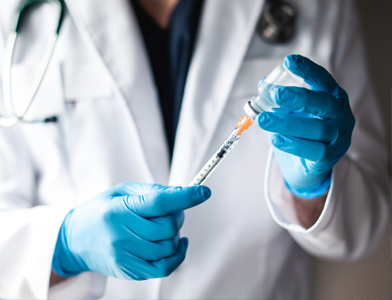5 Things To Know Now That the J&J Pause Is Lifted
After a 10-day pause on the Johnson & Johnson COVID-19 vaccine, the CDC has recommended that use of the vaccine resume at vaccination sites across the United States.
 Along with the approval comes a new warning: Blood clots involving blood vessels in the brain, abdomen and legs, along with low levels of platelets (blood cells that help your body stop bleeding), have occurred in some people who have received the Johnson & Johnson COVID-19 vaccine.
Along with the approval comes a new warning: Blood clots involving blood vessels in the brain, abdomen and legs, along with low levels of platelets (blood cells that help your body stop bleeding), have occurred in some people who have received the Johnson & Johnson COVID-19 vaccine.
Learn about the CDC’s guidance and more, as we answer the top questions that come with the return of the Johnson & Johnson COVID-19 vaccine.
Why did the CDC pause use of the Johnson & Johnson COVID-19 vaccine?
In early April 2021, a small number of people that received the Johnson & Johnson COVID-19 vaccine all developed the same blood-clotting disorder. Though the occurrence of the disorder was extremely rare, it was also extremely serious. The CDC and FDA wanted to pause the use of the vaccine out of an abundance of caution. They wanted time to review the vaccine for safety. They also wanted time to tell healthcare providers what symptoms to look for and how to treat this serious side effect.
Why did the CDC decide to resume use of the Johnson & Johnson COVID-19 vaccine?
After a thorough review of all available vaccine data, the CDC and FDA have concluded that the vaccine is safe and effective in preventing COVID-19. They also determined that the potential benefits of the vaccine outweigh the risks. With the recommendation to resume use of the vaccine comes the important warning that a small number of people who have received the Johnson & Johnson COVID-19 vaccine have developed serious blood-clotting disorders. Find out what symptoms of this condition look like below.
What are the health problems linked to the Johnson & Johnson COVID-19 vaccine?
Some people who have received the Johnson & Johnson COVID-19 vaccine have developed blood clots in the brain, abdomen and legs, along with low levels of platelets. Platelets are blood cells that help your body stop bleeding. The condition is called thrombosis with thrombocytopenia syndrome, or TTS. Symptoms of TTS can start between six and 15 days after you’re vaccinated. Look for any of these symptoms for up to three weeks after you get the vaccine:
- Severe or persistent headaches or blurred vision
- Shortness of breath
- Chest pain
- Leg swelling
- Persistent abdominal pain
- Easy bruising or tiny blood spots under the skin beyond the injection site
Seek medical care as soon as possible if you develop one or more of these symptoms. Because of the rare combination of blood clotting and low platelet levels, treatment for this rare and serious blood-clotting disorder is different than treatment for other types of blood clots. Healthcare providers across the United States are now aware of the appropriate way to care for patients with TTS.
Who is at risk for developing side effects?
Experts aren’t sure who, specifically, is at higher risk of developing TTS. Most people who developed these blood clots were women between 18 and 49. But the side effect has also been seen in men. No matter your age or gender, the side effect is very serious. If you display any of the symptoms above, it’s important you seek medical care immediately.
Should I still get the COVID-19 vaccine?
The COVID-19 vaccines are a proven way to avoid serious illness and hospitalization from the virus. Plus, the vaccine is our greatest hope for ending the pandemic. But like all big decisions, it’s yours to make. It’s good to have as much information as possible when taking risk. And in this case, the rare side effects that come with the Johnson & Johnson vaccine have not occurred in recipients of other authorized COVID-19 vaccines. If you’re concerned about your risk, you may want to get your vaccine at a site using the Moderna or Pfizer vaccines. If you’re still unsure, be sure to discuss your health concerns with your doctor before getting vaccinated.